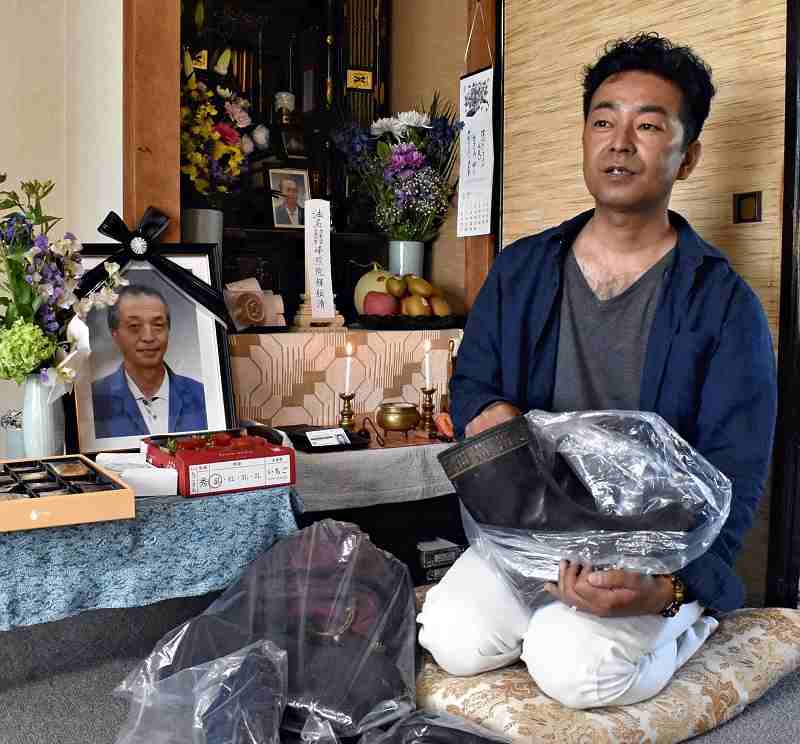
Takayuki Sakai talks about his memories of his father Kiyokatsu as he holds his father’s boots in Furubira, Hokkaido, on June 27. The boots have marks made by a bear.
13:47 JST, September 30, 2021
SAPPORO — A nearly record number of bear attacks on people have been documented in Hokkaido this year. But this story begins last spring, when Kiyokatsu Sakai, 71, went missing and was later confirmed to have died from a bear attack.
Saddened at the loss of his father, Takayuki, a company employee from Otaru, Hokkaido, began sharing information about the animal’s ecology and how to avoid the risk of attack, hoping to “cut down on incidents involving bears and humans.”
Bloody backpack
“I can’t find Dad.”
On the evening of May 15 last year, Takayuki, 47, received a call from his younger sister, saying that their father had gone missing. Takayuki, who was in Sapporo at that time, rushed to his parents’ home in the town of Furubira, west of Otaru.
At Kiyokatsu’s house, Takayuki found a note on a desk reading “Bamboo shoots from noon,” and them found his father’s truck on a hill behind the house. Town officials, police officers and firefighters conducted a search using a helicopter until late at night but could not find him.
The next day, his father’s bloodstained backpack and pieces of his skin were found in the mountains about 500 meters from his house, and paw prints and droppings believed to be from a bear were scattered nearby.
A bear was later caught in a trap set by the town, but Kiyokatsu was never found.
Warning period
Lost in grief, Takayuki began learning more about bears out of regret that his father “could have prevented the accident if he had known about the animals.”
Takayuki visited the Hokkaido Research Organization, which studies bears, and learned about how they live and how the local government take measures to prevent such incidents.
He learned that the Hokkaido prefectural government issues warnings every spring and autumn under the title “Use Extreme Caution: Brown Bear Increased Activity Period.”
During this period, bears actively roam in search of food before and after hibernation. This happens to be the same period that people tend to search around mountains for edible wild plants. It was during this period when Kiyokatsu was attacked.
Until his father’s death, Takayuki said he had never thought about bears very much.
“I don’t want bloodshed or tearful accidents to happen again,” he said, explaining his motivation to inform the public of how to avoid the risk of bear attacks.
Peaceful coexistence
In June, Takayuki began Kumanowa Kissa-shitsu, posting a video via social media about bears, giving such advice as “Lost cubs often look for places to live, and they may end up living in a place where food waste is,” and “Mowing grass helps define the boundaries between the wild and human communities, which is effective for helping to prevent encounters with bears.”
While learning more about bears, Takayuki got to know hunters and groups that work to deter bear attacks and asked them to share their knowledge. Beyond simple risk avoidance, Kumanowa encourages lively discussions on how to coexist with bears.
“Bears are important to protect beautiful Hokkaido,” said Takayuki, who also hosts discussions while sharing his own story about his father. He holds these discussions twice a month, and is planning to launch an educational campaign visiting various places in Hokkaido.
The police confirmed Kiyokatsu’s death, citing that he was “highly likely attacked by a wild animal.” His death was certified this spring, and the funeral was held in mid-June.
“His remains haven’t been found, and I’m struggling to find closure,” Takayuki said. “But, I think my father is watching over me from the mountain. My activities can eliminate unfortunate accidents for humans and bears.”
Stay calm
In Hokkaido, bear attacks occur almost every year, mainly in mountainous areas.
According to the Hokkaido prefectural police, bear attacks have killed one and injured six between January and June this year. The figure is close to surpassing the record high of eight people in 1964, two years after statistics started in 1962.
Hokkaido University Associate Prof. Michito Shimozuru, who specializes in veterinary medicine, has shared three tips to avoid the risk of encountering bears in mountains: Don’t walk alone; Make your presence known with bells and your voice; Don’t leave garbage.
When you encounter a bear, and if there is a certain distance between you and the bear, you should step back slowly while watching the bear’s movements.
Bears bluff their charges to scare or intimidate, but this act often does not lead to an attack.
“It’s important to stay calm so as not to make noise or to excite bears,” Shimozuru said.
"Society" POPULAR ARTICLE
-

M4.9 Earthquake Hits Tokyo, Neighboring Prefectures
-

M7.5 Earthquake Hits Northern Japan; Tsunami Waves Observed in Hokkaido, Aomori and Iwate Prefectures
-

Israeli Tourists Refused Accommodation at Hotel in Japan’s Nagano Pref., Prompting Protest by Israeli Embassy and Probe by Prefecture
-

Tsukiji Market Urges Tourists to Avoid Visiting in Year-End
-

M5.7 Earthquake Hits Japan’s Kumamoto Pref., Measuring Upper 5 Intensity, No Tsunami Expected
JN ACCESS RANKING
-

Keidanren Chairman Yoshinobu Tsutsui Visits Kashiwazaki-Kariwa Nuclear Power Plant; Inspects New Emergency Safety System
-

Imports of Rare Earths from China Facing Delays, May Be Caused by Deterioration of Japan-China Relations
-

University of Tokyo Professor Discusses Japanese Economic Security in Interview Ahead of Forum
-

Japan Pulls out of Vietnam Nuclear Project, Complicating Hanoi’s Power Plans
-

Govt Aims to Expand NISA Program Lineup, Abolish Age Restriction



















